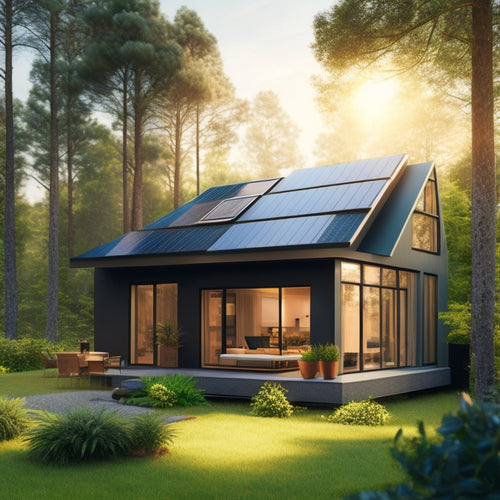
Calculating Home Solar Cost Made Easy
Share
You're about to commence an essential calculation of your home solar cost, which involves breaking down the upfront investment into solar panel types, installation costs, and additional expenses like inverters and mounting hardware. Next, you'll need to assess your energy needs by reviewing past utility bills to determine your average daily energy usage. Then, evaluate your roof's characteristics and sunlight exposure to determine its solar potential. Incentives and rebates, such as the federal tax credit, can also offset upfront costs. By factoring in all these components, you'll be able to calculate your total system cost and uncover the long-term savings that await you.
Key Takeaways
- Calculate total system cost by considering equipment purchase, installation, and maintenance expenses, as well as financing options and warranties.
- Assess energy needs by reviewing past utility bills and evaluating lifestyle changes to determine the required system size.
- Evaluate roof characteristics, sunlight exposure, and shading analysis to determine the optimal panel orientation and system effectiveness.
- Take advantage of federal and state incentives, such as the Investment Tax Credit, to reduce upfront costs and increase long-term savings.
- Consider additional factors, including battery storage, grid connection, and performance monitoring, to optimize system performance and energy independence.
Understanding Solar Panel Costs
Contemplating the significant upfront investment, understanding solar panel costs is essential in determining the viability of a home solar project. You need to know what you're paying for and what you can expect in return.
Solar panel costs vary depending on the type of panel you choose. There are three main solar panel types: monocrystalline, polycrystalline, and thin-film. Monocrystalline panels are the most efficient but also the most expensive, while thin-film panels are the least efficient but also the cheapest.
Installation costs are another significant factor in determining the overall cost of your solar panel system. These costs include labor, permits, and equipment.
The installation cost per watt of solar power can range from $2.50 to $3.50, depending on the complexity of the installation and the location of your home. You'll also need to take into account the cost of inverters, mounting hardware, and electrical connections.
Assessing Your Energy Needs
Evaluating Your Energy Needs
About 90% of your solar panel system's effectiveness depends on its ability to meet your energy needs. To accurately determine your energy needs, you'll need to evaluate your current energy consumption. Review your past utility bills to identify your average daily energy usage in kilowatt-hours (kWh). This will give you a baseline for sizing your solar panel system.
| Energy Usage | Average Daily Consumption (kWh) | Potential Lifestyle Changes |
|---|---|---|
| Low | 10-20 kWh | Reduce energy consumption with energy-efficient household appliances |
| Medium | 20-40 kWh | Implement energy-saving habits, such as turning off lights and electronics when not in use |
| High | 40-60 kWh | Consider investing in energy-efficient upgrades, such as LED lighting and smart home devices |
Evaluating Roof and Location
You'll need to assess your roof's size and shape to determine if it can accommodate a solar panel system.
The amount of sunlight your roof receives is also essential, as shade from trees or nearby buildings can greatly impact energy production.
Roof Size and Shape
Most homes have a unique roof size and shape, which greatly impacts the number of solar panels that can be installed and their overall efficiency.
When evaluating your roof, consider its size and shape to determine the best solar panel layout. A larger roof can accommodate more panels, increasing energy production, while an irregular shape may require more complex installation.
You'll also need to assess your roof's orientation, as a south-facing roof receives the most sunlight. East- and west-facing roofs receive less sunlight, but can still be suitable for solar panels.
A shading analysis is also important, as obstructions like trees, chimneys, or skylights can reduce energy production. By accounting for these factors, you can determine the ideal solar panel configuration for your roof, ensuring maximum energy output.
A professional solar installer can perform a detailed assessment to provide an accurate calculation of your home's solar potential.
Sunlight Exposure Matters
As you determine the ideal solar panel configuration for your roof, sunlight exposure becomes an essential factor. Sunlight angles, seasonal variations, and weather patterns all impact the amount of energy your solar panels can generate.
Geographic differences in sunlight exposure also play a significant role, with locations near the equator receiving more direct sunlight than those at higher latitudes.
Shading effects from trees, buildings, or other obstructions can reduce energy efficiency, making the best positioning vital. Panel orientation is also key, as south-facing panels typically receive the most sunlight.
Consider solar tracking systems, which adjust panel angle to maximize energy production. Even roof materials can affect sunlight exposure, with darker materials absorbing more heat and potentially reducing panel efficiency.
To guarantee maximum energy output, assess your roof's sunlight exposure by evaluating these factors.
Consider consulting with a solar professional to determine the best configuration for your specific location and roof conditions.
Incentives and Rebate Options
You'll be pleased to know that there are several incentives and rebate options available to help reduce the upfront cost of going solar.
The federal government offers a tax credit that allows you to claim a percentage of your solar panel system's cost as a credit on your taxes.
Additionally, many states and local governments offer their own incentives, such as rebates, tax credits, or property tax exemptions, which can further reduce your out-of-pocket expenses.
Federal Tax Credits
The Investment Tax Credit (ITC) is an essential federal incentive that considerably reduces the upfront cost of going solar. As a homeowner, you're eligible for a tax credit of 26% of your total solar panel system cost. This means you can claim 26% of your solar panel system's cost as a credit on your federal taxes, considerably reducing your tax liability.
For example, if your solar panel system costs $20,000, you can claim a $5,200 tax credit. This federal benefit can be claimed on your tax return, providing substantial tax savings.
To claim the ITC, you'll need to file Form 5695 with your tax return. You'll also need to keep records of your solar panel system's cost and installation, as well as proof of payment.
The ITC is a non-refundable credit, meaning you can only claim it up to the amount of taxes you owe. However, any unused credit can be carried over for up to 20 years.
State and Local Incentives
Your state and local government offer additional incentives to encourage homeowners to adopt solar energy, providing a welcome supplement to the federal tax credit.
These incentives can greatly reduce your upfront solar panel costs, making it more affordable to utilize renewable energy. You may be eligible for state tax credits, exemptions, or rebates, depending on your location.
Local programs, such as property tax exemptions or low-interest loans, can also help offset the cost of going solar. To determine your incentive eligibility, you'll need to submit rebate applications, which often require documentation of your solar panel installation.
Funding options may also be available through utility partnerships or community solar programs, which allow multiple individuals or organizations to share the benefits of a single solar array.
Calculating Total System Cost
Determining the total system cost is an essential step in evaluating the feasibility of a home solar installation. When calculating this cost, you'll need to take into account several factors beyond the initial equipment purchase.
You'll need to factor in installation expenses, which can vary depending on the complexity of the installation and the contractor you select. Additionally, you'll need to take into account maintenance costs, which can include regular cleaning and replacement of inverters.
The equipment choices you make will also impact your total system cost. For instance, opting for high-efficiency panels may increase upfront costs, but they can provide better energy efficiency in the long run.
System size is another crucial factor, as a larger system will generally cost more. You'll also need to take into account financing options, such as loans or power purchase agreements, which can affect your overall cost.
Moreover, don't forget to factor in grid connection fees, warranty details, and performance monitoring costs. By carefully evaluating these factors, you can get an accurate estimate of your total system cost and make an informed decision about your home solar installation.
Long-Term Savings and ROI
As you factor in the total system cost, it's equally important to evaluate the long-term benefits of your home solar installation. One significant advantage is energy independence, which comes with reduced reliance on the grid. With solar power, you'll enjoy lower energy bills and a decreased environmental impact.
In addition, you can take advantage of financing options that allow you to spread the cost over time, making the shift to solar more accessible.
When evaluating your long-term savings, consider the system's performance, insurance considerations, and maintenance costs. A well-maintained system guarantees peak energy efficiency and reduces the likelihood of costly repairs.
Battery storage can also enhance your energy independence by storing excess energy generated during the day for use at night or during outages. Moreover, a grid connection allows you to sell excess energy back to the utility company, further offsetting your costs.
Frequently Asked Questions
Can I Install Solar Panels on a Metal or Tile Roof?
You can install solar panels on a metal or tile roof, but you'll need to take into account specific installation factors, such as roof compatibility, to guarantee a secure and efficient setup that maximizes your energy output.
Will Solar Panels Increase My Property Taxes?
Like a superhero cape, solar panels can shield you from rising energy costs, but will they increase your property taxes? Not necessarily; many states offer property tax exemptions, and solar panel assessments are often minimal, so you'll likely fly under the radar.
Are Solar Panels Covered Under My Homeowner's Insurance?
You'll likely find that solar panels are covered under your homeowner's insurance, but it's crucial to review your policy to verify; additionally, check your solar panel warranties to guarantee overlapping coverage and avoid gaps in protection.
Can I Sell Excess Energy Back to the Grid?
You're literally sitting on a goldmine of excess energy! With net metering benefits, you can sell it back to the grid and earn energy credits, offsetting your utility bills and maximizing your solar investment's ROI.
Do Solar Panels Require Regular Maintenance?
You'll be relieved to know that solar panels require minimal maintenance; their lifespan averages 25-30 years. Follow maintenance tips like cleaning panels, inspecting connections, and monitoring performance to guarantee peak energy production and extend their lifespan.
Related Posts
-

Why Certification Matters for Residential Panels
You're looking to understand why certification matters for residential panels. Basically, third-party certification g...
-

Eco-Friendly Car Battery Solutions Available Online
You can now shop online for eco-friendly car battery solutions that not only reduce your carbon footprint but also of...
-

Reduce Solar Panel Cost for Your Small Home
By evaluating your energy needs, choosing the right installer, and selecting cost-effective solar panel options, you ...


